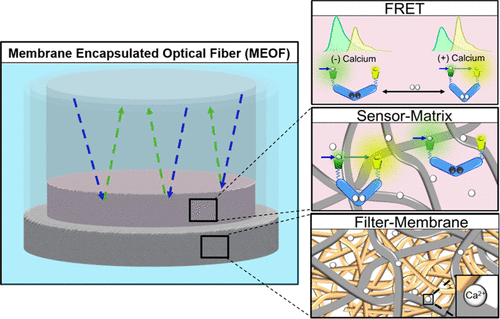当前位置:
X-MOL 学术
›
Anal. Chem.
›
论文详情
Our official English website, www.x-mol.net, welcomes your
feedback! (Note: you will need to create a separate account there.)
Photostable and Proteolysis-Resistant Förster Resonance Energy Transfer-Based Calcium Biosensor.
Analytical Chemistry ( IF 6.7 ) Pub Date : 2020-04-30 , DOI: 10.1021/acs.analchem.0c00573 Dat Nguyen 1 , Danielle M Behrens 1 , Sanjana Sen 2 , Avid Najdahmadi 3 , Jessica N Pham 4 , Gaetano Speciale 4 , Micah M Lawrence 1 , Sudipta Majumdar 4 , Gregory A Weiss 2, 4, 5 , Elliot L Botvinick 1, 3, 6
Analytical Chemistry ( IF 6.7 ) Pub Date : 2020-04-30 , DOI: 10.1021/acs.analchem.0c00573 Dat Nguyen 1 , Danielle M Behrens 1 , Sanjana Sen 2 , Avid Najdahmadi 3 , Jessica N Pham 4 , Gaetano Speciale 4 , Micah M Lawrence 1 , Sudipta Majumdar 4 , Gregory A Weiss 2, 4, 5 , Elliot L Botvinick 1, 3, 6
Affiliation

|
Molecular sensors from protein engineering offer new methods to sensitively bind to and detect target analytes for a wide range of applications. For example, these sensors can be integrated into probes for implantation, and then yield new and valuable physiological information. Here, a new Förster resonance energy transfer (FRET)-based sensor is integrated with an optical fiber to yield a device measuring free Ca2+. This membrane encapsulated optical fiber (MEOF) device is composed of a sensor matrix that fills poly(tetrafluoroethylene) (PTFE) with an engineered troponin C (TnC) protein fused to a pair of FRET fluorophores. The FRET efficiency is modulated upon Ca2+ ion binding. The probe further comprises a second, size-excluding filter membrane that is synthesized by filling the pores of a PTFE matrix with a poly(ethylene glycol) dimethacrylate (PEGDMA) hydrogel; this design ensures protection from circulating proteases and the foreign body response. The two membranes are stacked and placed on a thin, silica optical fiber for optical excitation and detection. Results show the biosensor responds to changes in Ca2+ concentration within minutes with a sensitivity ranging from 0.01 to 10 mM Ca2+, allowing discrimination of hyper- and hypocalcemia. Furthermore, the system reversibly binds Ca2+ to allow continuous monitoring. This work paves the way for the use of engineered structure-switching proteins for continuous optical monitoring in a large number of applications.
中文翻译:

基于光稳定性和耐蛋白水解性的Förster共振能量转移钙生物传感器。
蛋白质工程领域的分子传感器提供了新方法,可以灵敏地结合并检测目标分析物,从而适用于广泛的应用。例如,这些传感器可以集成到用于植入的探针中,然后产生新的有价值的生理信息。在这里,新的基于Förster共振能量转移(FRET)的传感器与光纤集成在一起,产生了一种测量游离Ca 2+的设备。这种膜封装的光纤(MEOF)设备由传感器矩阵组成,该传感器矩阵将融合有一对FRET荧光团的工程化肌钙蛋白C(TnC)蛋白填充到聚四氟乙烯(PTFE)中。FRET效率在Ca 2+上调节离子结合。该探针还包括第二不限尺寸的滤膜,该滤膜通过用聚(乙二醇)二甲基丙烯酸酯(PEGDMA)水凝胶填充PTFE基质的孔而合成。这种设计可确保免受循环蛋白酶和异物反应的影响。将两个膜堆叠并放置在细的石英光纤上,以进行光激发和检测。结果表明,该生物传感器可在数分钟内响应Ca 2+浓度的变化,其灵敏度范围为0.01至10 mM Ca 2+,从而可以区分高钙血症和低钙血症。此外,系统可逆地结合Ca 2+以便进行连续监控。这项工作为将工程化结构转换蛋白用于大量应用中的连续光学监测铺平了道路。
更新日期:2020-04-30
中文翻译:

基于光稳定性和耐蛋白水解性的Förster共振能量转移钙生物传感器。
蛋白质工程领域的分子传感器提供了新方法,可以灵敏地结合并检测目标分析物,从而适用于广泛的应用。例如,这些传感器可以集成到用于植入的探针中,然后产生新的有价值的生理信息。在这里,新的基于Förster共振能量转移(FRET)的传感器与光纤集成在一起,产生了一种测量游离Ca 2+的设备。这种膜封装的光纤(MEOF)设备由传感器矩阵组成,该传感器矩阵将融合有一对FRET荧光团的工程化肌钙蛋白C(TnC)蛋白填充到聚四氟乙烯(PTFE)中。FRET效率在Ca 2+上调节离子结合。该探针还包括第二不限尺寸的滤膜,该滤膜通过用聚(乙二醇)二甲基丙烯酸酯(PEGDMA)水凝胶填充PTFE基质的孔而合成。这种设计可确保免受循环蛋白酶和异物反应的影响。将两个膜堆叠并放置在细的石英光纤上,以进行光激发和检测。结果表明,该生物传感器可在数分钟内响应Ca 2+浓度的变化,其灵敏度范围为0.01至10 mM Ca 2+,从而可以区分高钙血症和低钙血症。此外,系统可逆地结合Ca 2+以便进行连续监控。这项工作为将工程化结构转换蛋白用于大量应用中的连续光学监测铺平了道路。















































 京公网安备 11010802027423号
京公网安备 11010802027423号